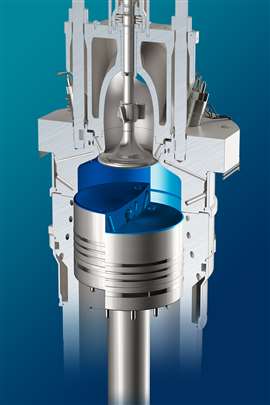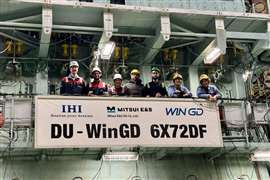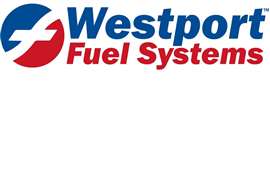Read this article in Français Deutsch Italiano Português Español
WinGD gets hundredth order for VCR technology for dual-fuel X-DF engines
28 August 2024
Swiss marine power company WinGD said it has received its hundredth order for Variable Compression Ratio (VCR) technology, which the company said further optimizes combustion for X-DF dual-fuel engines depending on the fuel used and engine load. WinGD launched the solution in June 2023.
 WinGD has received its hundredth order for Variable Compression Ratio (VCR) technology. (Image: WinGD)
WinGD has received its hundredth order for Variable Compression Ratio (VCR) technology. (Image: WinGD)
The milestone order came via a series of four liquified natural gas (LNG) carriers to be built for a Middle Eastern shipowner at a Korean shipyard, WinGD said. This joins several other orders for the LNG carrier segment over the past year, with further orders coming from the pure car and truck carrier, bulk carrier and container ship segments. Overall, WinGD said nearly 10 owners have selected the new technology as an option with their X-DF engines.
VCR technology enables the engine’s compression ratio to be dynamically adjusted for the fuel type being used, engine load and combustion behavior, WinGD said. This means higher compression ratios can be used when running on diesel, improving efficiency, while compression can also be tweaked during LNG use to optimize efficiency and reduce emissions. According to WinGD, the solution represents the first application of dynamic compression ratio adjustment in a marine engine.
Volkmar Galke, director of sales for WinGD, said 100 orders for VCR technology in its first year “indicates the strong market interest in technologies that can both reduce the environmental impact of gas-fueled engines and eliminate any compromise in diesel performance.”
VCR is the second X-DF2.0 technology introduced by WinGD as an enhancement to its X-DF dual-fuel engine platform. The first addition, Intelligent Control by Exhaust Recycling (iCER), has been deployed on most orders for LNG carriers over the past two years, the company said.
In recent tests, WinGD has established that X-DF engines with iCER and VCR achieve lower fuel consumption and emissions than other low-pressure engine technologies. Compared on a system-level, including main and auxiliary engines as well as fuel supply, the company said vessels can achieve a similar fuel consumption and emissions profile as those powered by high-pressure, diesel cycle two-stroke engines, while maintaining a capex advantage due to the low cost of the auxiliary system required.
POWER SOURCING GUIDE
The trusted reference and buyer’s guide for 83 years
The original “desktop search engine,” guiding nearly 10,000 users in more than 90 countries it is the primary reference for specifications and details on all the components that go into engine systems.
Visit Now
STAY CONNECTED




Receive the information you need when you need it through our world-leading magazines, newsletters and daily briefings.
CONNECT WITH THE TEAM














